The origins of the camp can be dated to
early 1940, when the SS sent a commission to
the Polish town of Oswiecim (German: Auschwitz) to determine whether a set of barracks that
had been constructed outside the town during WW1, and that between the wars
had been used by the Polish military, could be used as a concentration camp. Although the
initial report was negative, a later inspection determined that the change of use would be
possible after some construction works. Another commission, headed by
SS-Hauptsturmführer
Rudolf Höß, visited Auschwitz on
18-19 April 1940.
Höß' report seems to have carried the most weight,
for on
27 April 1940 Reichsführer-SS
Heinrich Himmler ordered the establishment of a concentration
camp in Auschwitz and on
4 May appointed
Rudolf Höß as its commandant.
The National Origins of Auschwitz Victims
Auschwitz was originally intended to serve as a concentration camp and a place of slow death for Polish
political prisoners and other Poles. In later years, it gradually became the main centre for the
systematic murder of those the Nazis considered human vermin, namely Jews and Roma. The Nazis'
pseudoscientific theories on the superiority of the Aryan race condemned more than one million people to
die in this place alone.
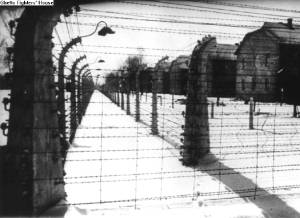 |
| Auschwitz I * |
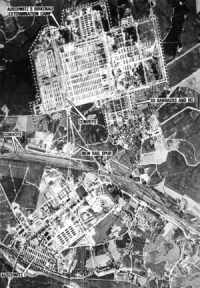 |
| Auschwitz I and II |
The first prisoners to be sent to Auschwitz, a group of 728 Polish political prisoners (including some Jews),
arrived in Auschwitz from
Tarnow on
14 June 1940.
The first large group sent to
Auschwitz from outside Poland was a transport of Czechs. This was in
June 1941.
Soviet prisoners of war started
arriving a month later (immediately after the Nazi invasion of the Soviet Union), and groups from Yugoslavia in
September 1941 - initially men, but by
July 1942
women as well. Among the latter were uniformed women partisans
who demanded to be treated as prisoners of war and refused to have their heads shaved.
Within a few months of the "Wannsee Conference" in
January 1942, where the
method by which the Jews of
Europe were to be murdered was discussed and agreed ("Final Solution of the Jewish Question"), Auschwitz
became one of the main camps to which Jews were to be sent for extermination. The first known transport,
composed entirely of Jews, arrived the very next month, and such transports continued to arrive from all
over occupied Europe until
November 1944.
In
September 1942 Rudolf Höß visited
Treblinka and
Chelmno
(
Chelmno nad Nerem / German:
Kulmhof) to
witness the gassing operations, as these differed from those used at Auschwitz. In his memoirs,
Höß stated that the methods used at
Treblinka and
Chelmno were primitive, and in
his opinion, inferior to those of his own camp.
In
1943 the Nazis started to murder Romany at Auschwitz, brought there for
this purpose, initially
from occupied Poland (starting in
February 1943) and later from other countries,
primarily the
Reich and Bohemia and Moravia.
The Auschwitz Complex
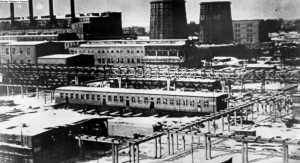 |
| Auschwitz III - Monowitz * |
Expanding Auschwitz's capacity, both to murder Jews and to assist in the Nazis' war effort through the
use of slave labour, was of paramount importance.
In
1940 Auschwitz I had 20 buildings. By
1942
there were 28 buildings, all of which had two storeys. Work commenced in
1942 on
building
Auschwitz-Birkenau, which could accommodate
200,000 people.
Birkenau is 2 miles away from Auschwitz I.
An additional satellite camp (Auschwitz III), the first of a series of forced labour camps,
was opened as part of the construction of a massive synthetic oil and rubber factory, known as
Buna Monowitz.
Thus the three main Auschwitz camps became one huge extermination complex, eventually to encompass not only
gas chambers and the camps themselves, but also 45 sub-camps, factories, and mines in Upper Silesia and the
Sudetenland.
Arrival at Auschwitz
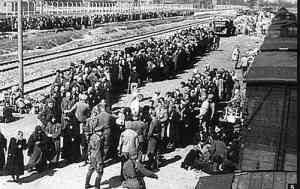 |
| Auschwitz II (Birkenau). Arrival at the Ramp |
 |
| Höß Telex |
People were transported to
Auschwitz-Birkenau by
trains, from all over Nazi-occupied Europe. They were generally sent in freight
cars or cattle trucks. Often they travelled for days without toilet facilities and with nothing to eat or drink.
Originally, the railway cars arrived at the
old ramp of
Birkenau,
1 km southeast of the entrance gate.
From
May 1944 they continued into Auschwitz II (
Birkenau /
Brzezinka) itself, along a specially constructed spur. The majority of the people, sent in these transports,
were murdered in gas chambers directly on arrival. Their names never appeared in the camp records, so that it is very
difficult to determine precisely how many perished from these transports.
Those the SS deemed fit for work were not murdered immediately but were used as slave labourers. They were given
striped prison clothing and a prisoner number. From
1943, most prisoners
(though never Germans, unless they
were Jewish) were tattooed with their numbers, generally on the left forearm. In all, more than 400,000 people,
members of all national and ethnic groups, were allocated numbers. Of these, about one half died. Few lived longer
than six months: they died from starvation, disease, the rigours of hard labour, beatings, torture, and summary
execution - by shooting, hanging or gassing.
Conditions in Auschwitz
Prisoners in Auschwitz I were initially housed in one-storey brick barracks, formerly used by the Polish Army for
stabling horses. When the number of inmates increased, a second storey was added to each barrack. At first the
prisoners slept on the floor: later two and three tier bunk beds were installed. Auschwitz I was a concentration
camp, with a regime similar to other camps of that kind. Amongst other "privileges", the inmates were allowed
to use the camp's
postal service.
Auschwitz II (
Birkenau) was a hybrid. Principally an extermination camp, it
also served as a concentration camp. Here the prisoners were housed in wooden or brick huts. The wooden huts were
based on the design for SS stables, and as many as 800 prisoners were sometimes crowded into a space designed for
fifty-two horses. Lavatories were extremely primitive and few in number. Prisoners had very limited time to relieve
themselves. Washing facilities were likewise, grossly insufficient.
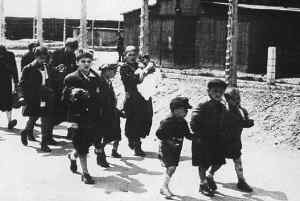 |
| Hungarian Jews on their way to the gas chambers |
"Work" meant slave labour in factories, mines, farming operations, and construction.
Even the heaviest tasks, such as excavation and earth moving, generally had to be undertaken without
equipment. Although prisoners were quite literally starving, they were often forced to carry bricks
or push barrows at a run. Any attempt to rest was punished by transfer to special penal units where
conditions were so very bad that few who experienced them survived.
Upon return to the camp after work a roll call was held. After the roll call, prisoners received a
meal which consisted of a small piece of bread (300 grams), some lard or margarine, and occasionally
about 100 grams of salted pork. Prisoners who had missed the noon meal because they had been
working outside the camp were given a soup as well, usually turnip or cabbage soup, but as it had
been poured out at noon it was a cold and tasteless pulp by the evening.
Prisoners were totally at the mercy of the SS and could be sadistically punished at any time for
infringement of the arbitrary camp rules. The usual punishment for infringements of this kind was
twenty-five or more lashes with a whip. Prisoners working in the labour camp were always subject to
summary execution. The principal sites in Auschwitz I where executions were carried out, were in the
cells of
Block 11 and the courtyard between
Blocks 10 and 11 ("The Death Wall"). Political prisoners
of the
Gestapo were also sent here from
Katowice for execution.
Gerhard Palitzsch was the sadistic chief executioner.
Maximilian Grabner, director of the Political Department, was
another prominent figure in these "clean-ups".
In addition, a portable gallows, which generally stood in the courtyard of
Block 11, was carried out to
the roll-call square for public executions. Phenol injections to the heart were another common method of execution
in Auschwitz.
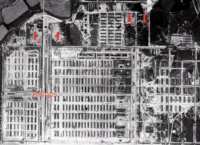 |
| Location of Bunker I and II |
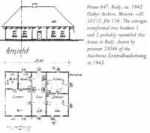 |
| Bunker I and II |
The first gassing in Auschwitz took place in the cellars of
Block 11 at the
end of August 1941, conducted
by
SS-Hauptsturmführer Karl Fritzsch, who used
Zyklon B gas
to kill Soviet prisoners of war.
Following this, 600 Soviet POWs and 250 Polish prisoners were gassed on
3 September 1941, in the cellars of
Block 11.
In
autumn 1941 the mortuary of Auschwitz I was converted into a gas chamber.
This first Auschwitz gas chamber was in use until
July 1943.
Later two additional gas chambers were put into operation, using converted farmhouses in
Birkenau. The first, known as the
"
Red House" (also "Bunker I"), was so called
because of its red brick structure. The first transport to be gassed in "Bunker I" was from
Beuthen, murdered on
15 February 1942.
The second, known as the
"
White House" (also "Bunker II"), was another
whitewashed farmhouse, hence its name. "Bunker I" was divided into two gas chambers, "Bunker II" into four.
Initially buried in mass graves, from
September 1942 the corpses of those
gassed in these bunkers were exhumed and
cremated. By late
November 1942 over
100,000 bodies had been burned. "Bunker I" was dismantled
in
spring 1943. "Bunker II" ceased operating at the same time, but the
bunker itself was left intact, to be
brought into operation again in
May 1944 during the extermination of the
Jews of Hungary. It remained
operative until
November 1944, when all gassing was discontinued.
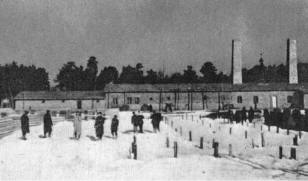 |
| Crematorium IV |
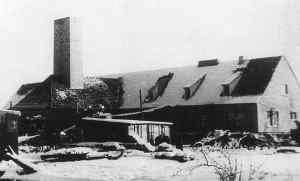 |
| Crematorium II |
Between March and June 1943, four very large gas chambers with adjacent
crematoria were activated at
Birkenau (Crematorium "II",
"
III", "IV" and
"
V"). Crematoria II and III were
identical, with undressing rooms and gas chambers beneath ground level. Crematoria IV and V were also of identical
construction, but with undressing, gassing and cremation carried out at ground level. Their principal victims were
Jews, transported to Auschwitz from all over Europe. The pace of the murders reached an apogee in the
summer of 1944,
when more than 400,000 Jews were transported from Hungary, over a period of two months. Most of the deportees
(especially the elderly, babies and children) were gassed immediately upon arrival, following selection by doctors,
such as
Mengele and
Thilo.
As mentioned earlier, in order to speed up the killings, a spur from the main railway line was extended directly
into the camp, stopping short of crematoria II and III.
The gassing was carried out using
Zyklon B (prussic acid) in pellets. In crematoria II and III the gas
was poured through vents in the roof directly into the gas chambers, in crematoria IV and V from apertures at
the side of the buildings.
Sonderkommando testimonies state that victims with whom the crematoria could not cope, were
burned in the open air. Sometimes people were pushed into the flames whilst still alive.
Conclusion
Himmler ordered the immediate dismantling of the gassing facilities
after the
Sonderkommando revolt in crematorium IV on
7 October 1944.
In
January 1945, about 58,000 prisoners
were forced to begin "death marches" to the west due to the approach of the Red Army. Most of the prisoners
died on these marches, which lasted for weeks. Those lagging behind were shot and left at the side of the
paths and roads.
On
27 January 1945 soldiers of the Red Army entered Auschwitz and liberated
7,650 prisoners. These had also
been earmarked for death, had the SS had more time before evacuating the camp. Due to this "lack of time" the
SS could not destroy all buildings and structures as had been done in
Belzec,
Sobibor and
Treblinka. Therefore today's visitors at the
Auschwitz Memorial can obtain a good impression of the former
concentration / extermination camp.
According to
Franciszek Piper (Franciszek Piper:
Ilu ludzi
zginelo w KL Auschwitz? Oswiecim 1992) the total number murdered at Auschwitz I, II and III was
approximately 1,100,000. Included among the victims were 1,000,000 Jews, 70-75,000
non-Jewish Poles, 21,000 Sinti and Roma, 15,000 Soviet POWs and 10-15,000
persons from other countries.
Research by
Götz Aly and
Christian Gerlach suggests that the total number killed was
perhaps somewhat lower, with at least approximately 1 million victims,
of whom about 900,000 were Jewish.
Höß statement from 16 March 1946.
Auschwitz Perpetrators
Photos:
GFH *
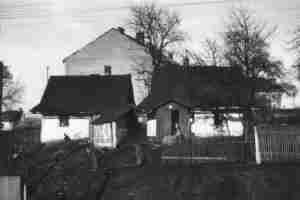 |
| Auschwitz: Jewish Quarters 1940 |
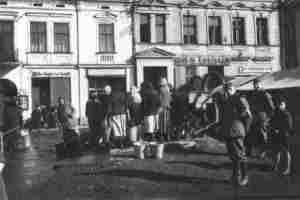 |
| Auschwitz: Market Square and Well 1940 |





















